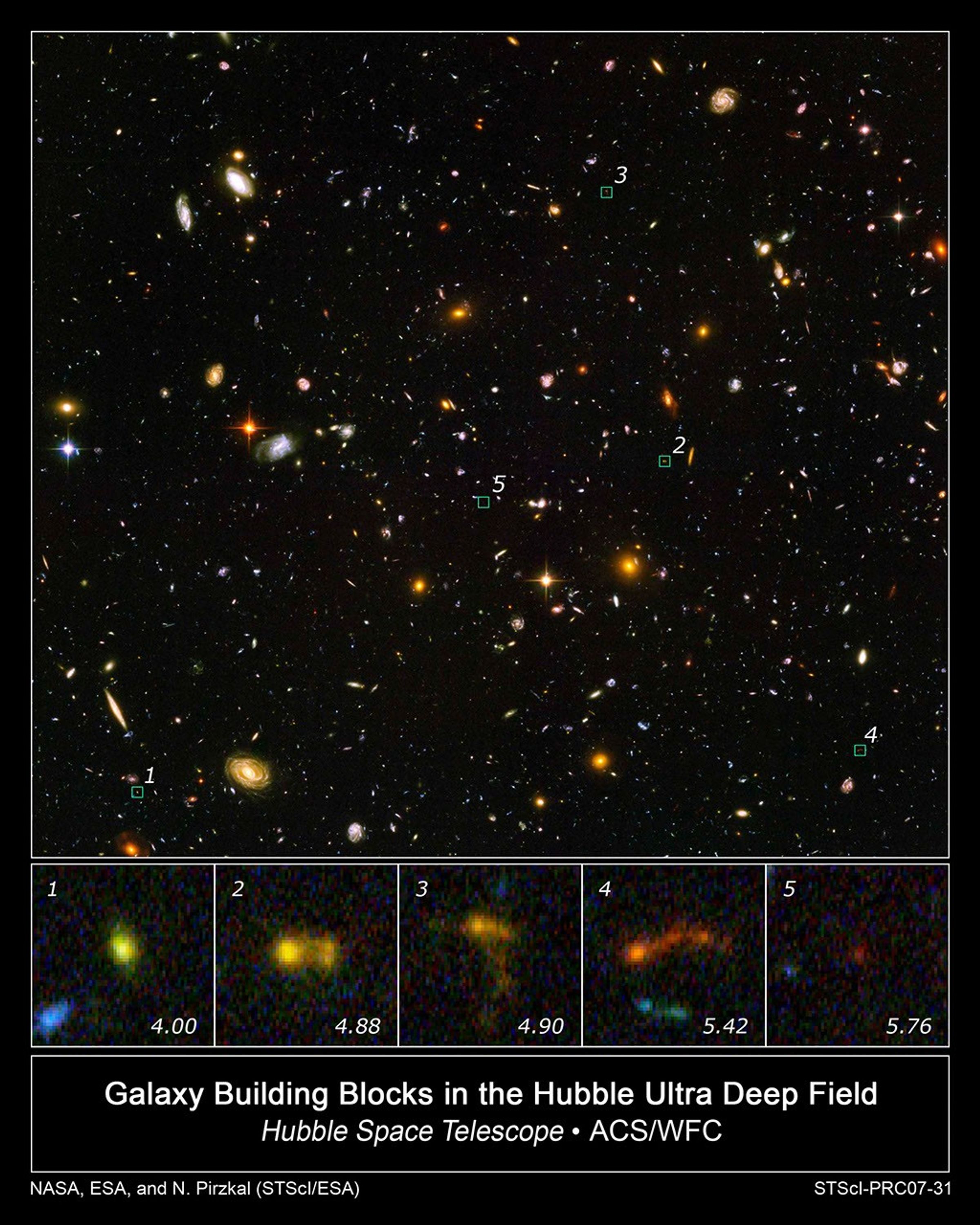1 min read
Hubble and Spitzer Uncover Smallest Galaxy Building Blocks

In this image of the Hubble Ultra Deep Field, several objects are identified as the faintest, most compact galaxies ever observed in the distant universe. They are so far away that we see them as they looked less than one billion years after the Big Bang. Blazing with the brilliance of millions of stars, each of the newly discovered galaxies is a hundred to a thousand times smaller than our Milky Way Galaxy.
The bottom row of pictures shows several of these clumps (distance expressed in redshift value). Three of the galaxies appear to be slightly disrupted. Rather than being shaped like rounded blobs, they appear stretched into tadpole-like shapes. This is a sign that they may be interacting and merging with neighboring galaxies to form larger structures.
The detection required joint observations between Hubble and NASA's Spitzer Space Telescope. Blue light seen by Hubble shows the presence of young stars. The absence of infrared light from Spitzer observations conclusively shows that these are truly young galaxies without an earlier generation of stars.
About the Object
- R.A. PositionR.A. PositionRight ascension – analogous to longitude – is one component of an object's position.03h 31m 59.99s
- Dec. PositionDec. PositionDeclination – analogous to latitude – is one component of an object's position.-27° 48' 0.0"
- ConstellationConstellationOne of 88 recognized regions of the celestial sphere in which the object appears.Fornax
- DimensionsDimensionsThe physical size of the object or the apparent angle it subtends on the sky.The full HUDF image is 3 arcminutes square.
About the Data
- Data DescriptionData DescriptionProposal: A description of the observations, their scientific justification, and the links to the data available in the science archive.
Science Team: The astronomers who planned the observations and analyzed the data. "PI" refers to the Principal Investigator.GRAPES HST Data The science data were selected based on findings from The Grism-ACS Program for Extragalactic Science (GRAPES), HST proposal 9793: S. Malhotra et. al. The science team includes: N. Pirzkal (STSCI/ESA) S. Malhotra and J. Rhoads (Arizona State University), and C. Xu (Shanghai Institute of Technical Physics). HUDF HST Data This image of the HUDF was created from HST data from the following proposal: 9978: S. Beckwith, S. Malhotra, M. Giavalisco, N. Panagia, J. Rhoads, M. Stiavelli, R. Somerville, S. Casertano, B. Margon, C. Blades, J. Caldwell, and M. Clampin (STScI), M. Corbin (STScI/CSC), M. Dickinson, H. Ferguson, and A. Fruchter (STScI), R. Hook (STScI/ECF), S. Jogee, A. Koekemoer, R. Lucas, M. Sosey, and L. Bergeron (STScI). NICMOS HUDF Data The NICMOS HUDF data were from proposal 9803: R. Thompson (University of Arizona), G. Illingworth and R. Bouwens (university of California, Santa Cruz), M. Dickinson (STScI), D. Eisenstein and X. Fan (University of Arizona), M. Franx (University of Leiden), M. Rieke (University of Arizona), A. Riess (STScI), and P. van Dokkum (Yale University). The Spitzer science team includes: H. Yan (Caltech), M Dickinson (NOAO), D. Stern and P. Eisenhardt (Jet Propulsion Lab), R.-R. Chary (Caltech), M. Giavalisco (STScI), H. Ferguson and S. Casertano (STScI), C. Conselice (Caltech), C. Papovich (Steward Observatory), W. Reach (Caltech), N. Grogin (STScI), L. Moustakas (Jet Propulsion Lab), and M. Ouchi (STScI). - InstrumentInstrumentThe science instrument used to produce the data.HST>ACS/WFC, HST>ACS/NICMOS, and SST>IRAC
- Exposure DatesExposure DatesThe date(s) that the telescope made its observations and the total exposure time.September 24, 2003 - January 16, 2004, Exposure Time: 11.3 days (ACS/WFC), September 3, 2003 - November 27, 2003, Exposure Time: 11.3 days (ACS/NICMOS), and February 2004, Exposure Time: 5 days (IRAC)
- FiltersFiltersThe camera filters that were used in the science observations.ACS/WFC: F435W (B), F606W (V), F775W (i), F850LP (z) ACS/NICMOS: F110W (J110) and F160W (H160) IRAC: 3.6, 4.5, 5.8, and 8.0 microns
- Object NameObject NameA name or catalog number that astronomers use to identify an astronomical object.Galaxies in the Hubble Ultra Deep Field, HUDF, Hubble Ultra Deep Field
- Object DescriptionObject DescriptionThe type of astronomical object.Distant galaxies, Deep field survey
- Release DateSeptember 6, 2007
- Science ReleaseHubble and Spitzer Space Telescopes Find “Lego-Block” Galaxies in Early Universe
- Credit

Blue: F435W (B) Green: F606W (V) + F775W (i) Red: F850LP (z)

Related Images & Videos
Share
Details
Claire Andreoli
NASA’s Goddard Space Flight Center
Greenbelt, Maryland
claire.andreoli@nasa.gov


































